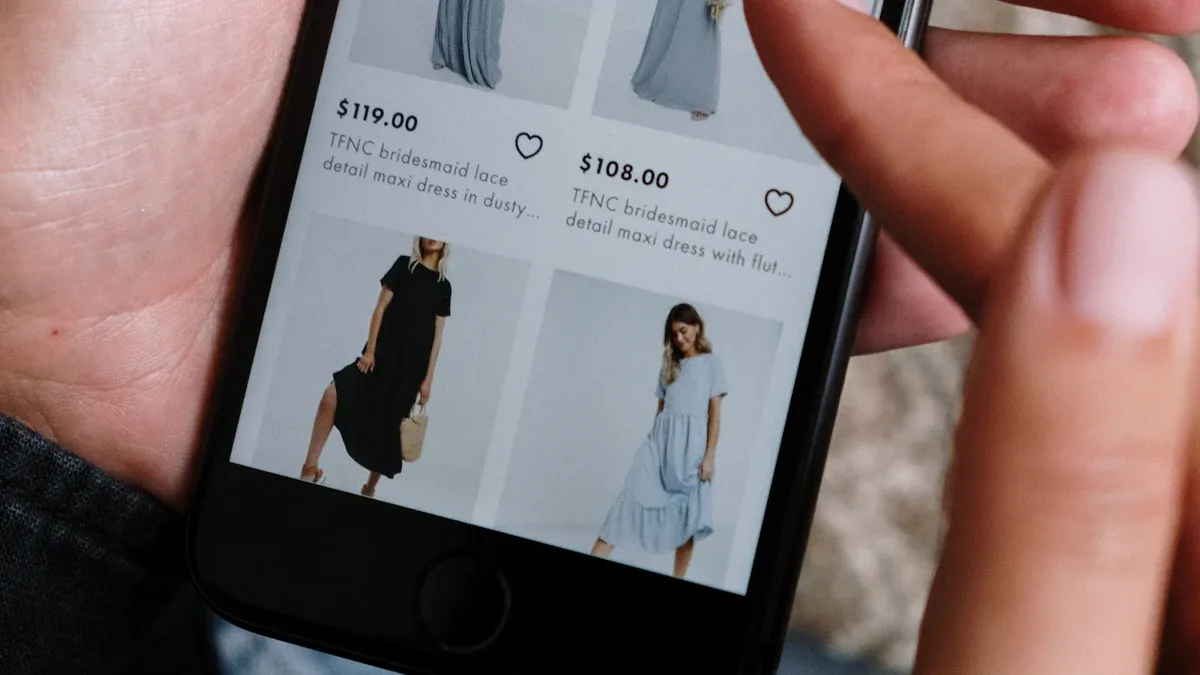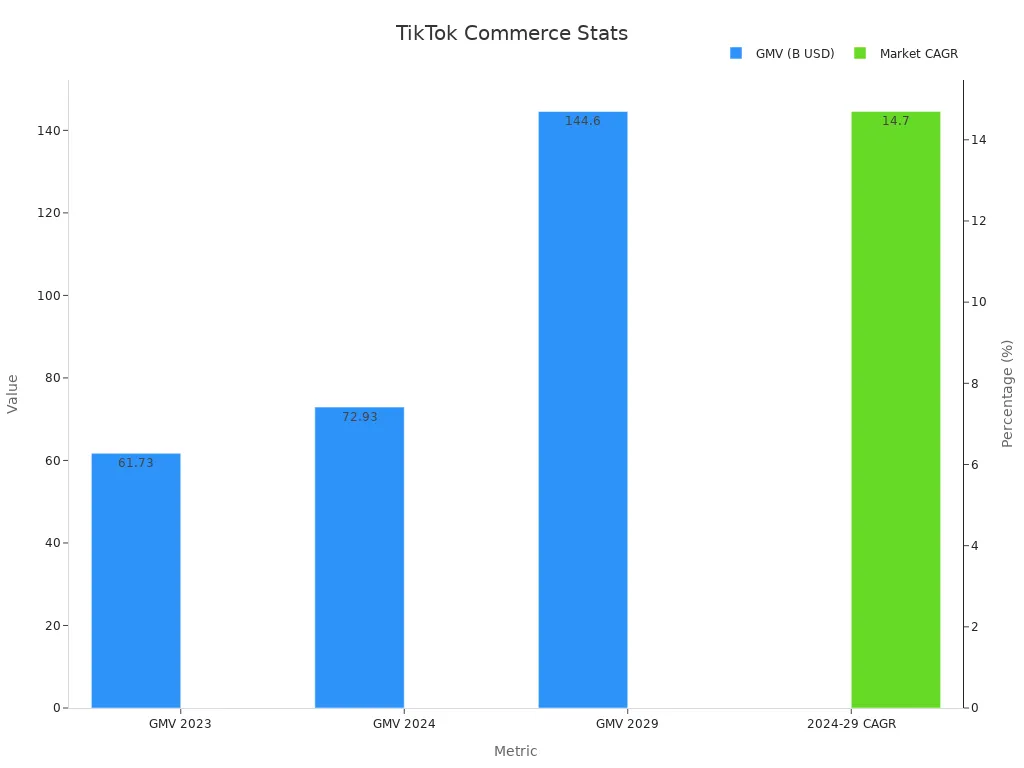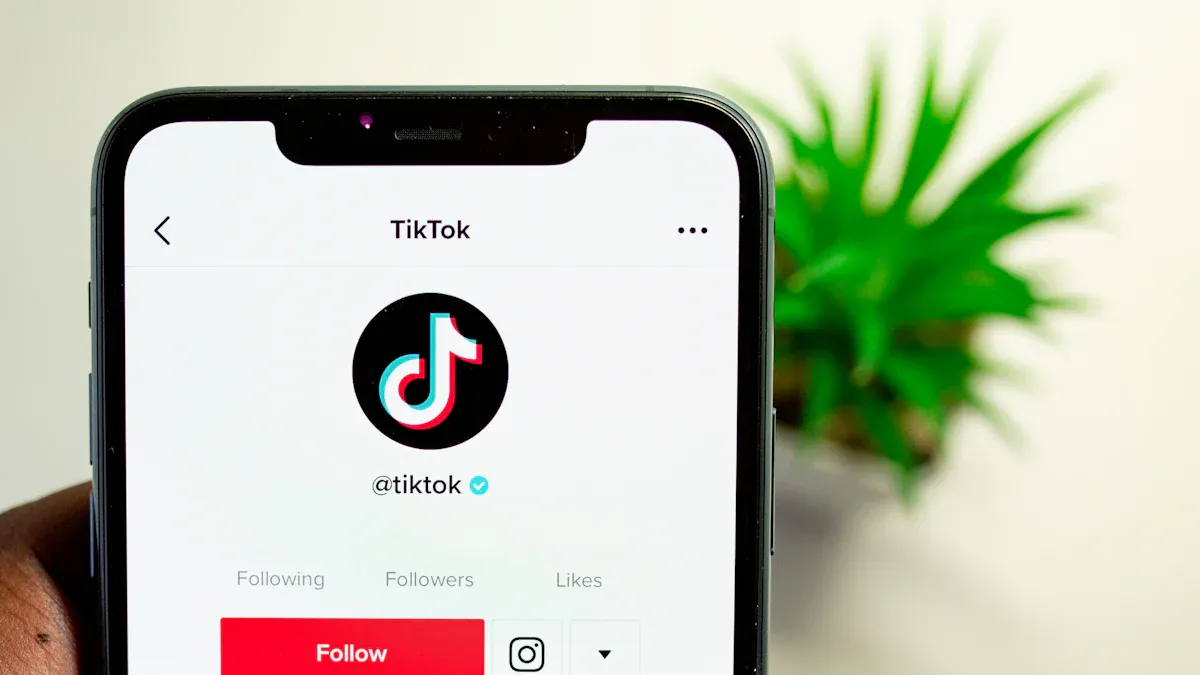TikTok Marketing and what retailers overlook in digital transformation

Retailers often view TikTok as only a social platform, yet the platform drives commerce and empowers creators. Recent statistics highlight TikTok's impact:
Statistic / Metric | Value / Description |
|---|---|
September 2023 | |
U.S. social commerce GMV (2023) | $61.73 billion |
U.S. social commerce GMV (2024 forecast) | $72.93 billion |
U.S. social commerce GMV (2029 forecast) | $144.6 billion |
TikTok sales share in beauty & personal care (Sept 2023) | Nearly 85% of TikTok's total sales |
Projected U.S. social commerce sales (2025) | Over $100 billion driven by Gen Z adoption and increased buyer spending |

Brands such as Kaffe have achieved up to 74.3% increases in sales with TikTok Marketing by using creator partnerships and data-driven strategies. Retailers who ignore this ecosystem risk missing deeper engagement and new revenue streams.
Key Takeaways
TikTok is more than a social platform; it drives significant commerce through native shopping tools and seamless in-app checkout, boosting sales and engagement.
Partnering with creators and using shoppable content helps brands reach new customers, increase conversions, and build lasting loyalty.
Interactive ads and AI-driven optimization improve campaign performance, making marketing efforts more effective and cost-efficient.
Using TikTok analytics and multi-touch attribution models allows retailers to measure success accurately and optimize their strategies.
Staying updated on TikTok’s changes, training teams, and embracing experimentation lead to continuous growth and a competitive edge.
TikTok Marketing: Overlooked Commerce Features

Native Shopping Tools
TikTok Marketing introduces native shopping tools that change how users interact with brands. TikTok Shop allows users to discover, evaluate, and purchase products without leaving the app. Brands see results through a phased approach. In the first month, they lay the foundation and test content. The second month focuses on optimization and building an audience. By the third month, brands drive momentum and conversions. This process helps brands measure direct purchases, assisted conversions, and long-term brand impact.
Brands using TikTok Shop report strong results. For example, small businesses achieve three times higher ROI compared to traditional digital marketing. Some partners see profit increases averaging 84%. TikTok Shop’s average order value is 35% higher than on traditional e-commerce sites. The conversion rate can reach up to 5.9%, showing the power of these native tools.
Metric Description | Value / Impact |
|---|---|
43% | |
Users taking action after watching content | 92% |
Purchase intent compared to other platforms | 71% higher |
TikTok Shop average order value | 35% higher than traditional e-commerce |
TikTok Shop conversion rate | Up to 5.9% |
Users inspired to learn more about products | 74% |
Average engagement rate on TikTok | 17.5% (higher than Instagram 3.8%, Facebook 1.2%) |
Small businesses ROI using TikTok Shop | 3x higher than traditional digital marketing |
Profit increase reported by some partners | Average 84% |
These numbers highlight why retailers should not overlook TikTok Marketing when planning their digital transformation.
Seamless In-App Checkout
Seamless in-app checkout stands out as a key feature in TikTok’s commerce ecosystem. Users can move from product discovery to purchase in just a few taps. This frictionless experience increases conversion rates and encourages impulse buying. TikTok’s checkout process supports direct payment, order tracking, and customer support—all within the app.
Many users feel inspired to shop while browsing TikTok. Over 70% of TikTok shoppers worldwide say they are likely to buy when they find interesting products. Two-thirds of users have made purchases while on the platform. Half of all users have bought something after watching TikTok LIVE. These behaviors show that seamless checkout is not just a convenience—it is a driver of sales.
Approximately 39% of all purchases are influenced by TikTok. Peer-driven recommendations and user-generated content play a bigger role than traditional advertising. Marketers who use TikTok Marketing can benefit from these behavioral shifts and build long-term brand loyalty.
Shoppable Content and Product Discovery
Shoppable content on TikTok makes product discovery easy and engaging. Brands use videos, live streams, and creator partnerships to showcase products in real-life scenarios. This approach leads to higher engagement and stronger purchase intent.
Key performance indicators prove the value of shoppable content:
KPI Name | What It Measures | Why It Matters | Example/Benchmark/Insight |
|---|---|---|---|
Percentage of viewers who click product links | Shows user interest and engagement | Good: 2-3%, Excellent: 4-5%+ | |
Click-to-Purchase Rate | Conversion from product click to actual sale | Measures effectiveness in driving purchases | Good: 8-12%, Excellent: 15%+ |
Save Rate | Users saving videos for later | Indicates purchase intent | Target: 3-5% of total views |
New-to-Brand Percentage | Portion of sales from first-time customers | Shows brand discovery effectiveness | Healthy balance: 60-70% new customers |
Repeat Purchase Rate | Customers buying again within 90 days | Indicates satisfaction and product fit | Benchmark: 25-35% for consumables, 15-25% for durables |
Customer Lifetime Value | Total revenue expected from each customer | Determines long-term value | TikTok Shop: 81.3% of sales from repeat customers |
Engagement rate measures likes, comments, and shares.
Click-through rate shows how many viewers click product links.
Influencer collaborations and TikTok challenges boost product visibility.
Clear calls to action in videos encourage shopping behavior.
Brands see real results. A coffee brand increased sales by 25% in one month using storytelling videos. A laundry soap brand achieved a 35% jump in click-through rates by leveraging TikTok trends. These examples show that shoppable content drives both discovery and sales.
TikTok Marketing helps brands reach new customers and build loyalty. Over half of users research new brands or products on TikTok. Users report more positive emotions about products purchased via TikTok than on other platforms. Monitoring KPIs like views, engagement, and conversion rates allows brands to optimize their strategy and maximize results.
TikTok Marketing: Strategic Partnerships and Creator Activations

Real-Time Creator Collaborations
Brands achieve rapid growth on TikTok by working with creators in real time. These collaborations allow brands to reach new audiences and drive sales quickly. Metrics such as cost per conversion, influencer reach, and live video engagement help brands measure the impact of these partnerships. For example, a 25% reply rate in creator outreach shows strong engagement, while an 80% hit rate for seeded creators posting content signals high campaign effectiveness. Brands also track gross merchandise value (GMV) to see the total sales generated by creator collaborations. Monitoring profitability, including operational and commission costs, ensures long-term success.
Brands that use real-time creator collaborations often see higher conversion rates and increased visibility. Live video performance, audience demographics, and video engagement metrics provide valuable insights for optimizing future campaigns.
Influencer Partnership Strategies
Successful brands use advanced tools to select the right influencers and maximize return on investment. AI-driven platforms like NeoReach analyze data to predict which influencers will perform best. Marketers aim for a 5:1 ROI ratio, meaning every dollar spent should generate five dollars in return. Influencer content on TikTok often doubles the conversion rate compared to brand accounts. The hashtag #TikTokMadeMeBuyIt, with over 12 billion views, highlights the platform’s power to inspire shopping. Long-term partnerships with top influencers help brands build credibility and achieve sustained growth.
Evidence Type | Description |
|---|---|
ROI Benchmark | 5:1 ratio is a strong goal for marketers. |
Viral Hashtag Impact | #TikTokMadeMeBuyIt has 12B+ views, showing strong eCommerce influence. |
Conversion Rate Comparison | Influencer content converts at 2x the rate of brand accounts. |
User Shopping Motivation | 67% of users shop after seeing influencer content. |
Campaign Example |
Community-Driven Campaigns
Community-driven campaigns help brands connect with audiences on a deeper level. TikTok users respond best to authentic, relatable content that builds a sense of belonging. Brands use relevant hashtags to reach niche communities, boosting likes, comments, and shares. User-generated content and participation in trending challenges encourage peer-to-peer sharing and increase engagement. Brands that respond quickly to comments and join trends create dynamic conversations and strengthen their presence. TikTok’s algorithm rewards content with high interaction, making it more likely to appear on the For You page and reach even more users.
Brands track engagement metrics such as likes, shares, and comments to measure campaign success.
Posting high-quality, trend-aligned content at the right times increases visibility and follower growth.
TikTok Marketing: Advanced Advertising and AI Optimization
Interactive Ad Formats
Brands on TikTok use interactive ad formats to capture attention and drive results. In-feed ads, branded hashtag challenges, and Spark Ads encourage users to engage with content. These formats help brands reach large audiences and boost campaign performance. For example, Bumble saw a fivefold increase in app installs and a 64% drop in cost-per-registration by combining in-feed ads with influencer content. Fendi achieved a 158% higher click-through rate than its benchmark using in-feed ads. KFC’s TopView Ads reached 221 million views and increased ad recall by nearly 25%.
Brand | Ad Format(s) | Key Results / Metrics |
|---|---|---|
Bumble | In-Feed Ads + Influencer | 5x app installs; 64% lower cost-per-registration |
Fendi | In-Feed Ads | 158% higher CTR |
KFC | TopView Ads | 221M views; 13.8% CTR; 24.7% higher ad recall |
Mucinex | Branded Hashtag Challenge + Branded Effects | 6B views; 500,000+ participants in 9 days |
Chipotle | Branded Hashtag Challenges + Organic | 1.3M followers; 20M+ likes |
These results show that interactive ad formats on TikTok deliver strong engagement and measurable business outcomes.
AI-Driven Creative Optimization
AI tools on TikTok help brands create better ads and improve campaign results. TikTok Creative Assistant uses data to suggest creative ideas that match audience interests. This assistant helps advertisers design content that stands out and connects with viewers. Brands using AI-driven optimization see higher conversion rates, better return on ad spend, and stronger brand recall. Conversion Lift Studies show a 25% increase in conversion rates when brands use AI to optimize their ads. Machine learning also improves overall campaign performance by predicting what content will work best.
Performance Metric | Description and Impact on Creative Output |
|---|---|
Conversion Rate | 25% increase with AI-driven optimization |
Return on Investment | Higher revenue from better ad spend allocation |
Ad Recall | More memorable content for viewers |
Brand Association | Stronger connection between brand and audience |
Campaign Performance | Improved KPIs and engagement |
Dynamic Product Ads
Dynamic product ads on TikTok use automation and data to show the right products to the right people. These ads adjust based on user interests, location, and behavior. Brands save time because the platform generates ads programmatically. Video quality and format matter: videos in 720p or higher see over three times more conversions, and vertical videos get a 91% higher conversion rate. TikTok’s average cost per click is about $1.00, making it cost-effective for advertisers. The platform’s dynamic product ads help brands reach a massive audience of over one billion users and drive more sales.
Dynamic product ads use advanced targeting to boost conversions.
Programmatic ad creation saves hundreds of hours for marketing teams.
Integration with e-commerce features increases sales and reduces purchase friction.
TikTok Marketing: Measurement and Attribution
TikTok Analytics and Insights
Retailers rely on TikTok analytics to understand their audience and improve performance. Analytics tools reveal who watches content, when they engage, and which videos perform best. Marketers track video views, watch time, and traffic sources to see how users discover and interact with posts. By analyzing follower activity times, brands can schedule posts for maximum engagement. Content refinement becomes easier when marketers know which sounds, hashtags, and trends resonate with viewers. Geographic data helps tailor campaigns to regions with the highest engagement. Competitive benchmarking and sentiment analysis allow brands to monitor reputation and compare results with rivals.
TikTok analytics tools provide:
Engagement metrics for each post
Features for custom reporting and content scheduling
Regular reviews of analytics help brands spot important patterns. Aligning tracked metrics with business goals, such as focusing on click-through rates for website traffic, leads to better outcomes. Experimentation with content types and posting schedules, guided by analytics, drives continuous improvement.
Multi-Touch Attribution Models
Multi-touch attribution models give marketers a clear view of how different touchpoints influence customer decisions. These models assign credit to each interaction, such as ads, influencer posts, or website visits, along the customer journey. By distributing credit across multiple touchpoints, marketers can optimize campaigns and allocate budgets more effectively. Multi-touch attribution supports smarter investments and higher conversion rates by revealing which channels drive results.
Multi-touch attribution enables:
Accurate measurement of campaign effectiveness
Deeper customer insights
Improved alignment between marketing and sales teams
Enhanced personalization and retargeting
Although these models require complex data and careful setup, the insights gained help brands adapt to modern, multi-channel consumer behavior.
Integrating Online and Offline Data
Successful retailers connect online and offline data to measure the full impact of their campaigns. Brands often blend offline product usage with online engagement to boost participation. For example, a campaign may encourage user-generated content and leverage trending sounds, leading to both online engagement and offline sales. Marketers track metrics like watch time, shares, conversions, and local store sales spikes to see how TikTok activity drives real-world outcomes.
A brand combines offline product use with app engagement to increase participation.
Campaigns use authentic storytelling and trending sounds to link TikTok activity with offline sales.
Metrics such as conversions and store sales spikes show how online interactions lead to offline results.
Creative calls-to-action prompt users to create videos, resulting in millions of views and increased sales.
Genuine stories in videos build trust and drive both online and offline purchases.
Platforms now allow brands to link online ad engagement with offline actions, making it possible to track how TikTok campaigns influence in-store sales and customer behavior. This integration helps marketers measure and optimize campaign effectiveness across all channels.
TikTok Marketing: Innovation and Continuous Learning
Staying Ahead of Platform Updates
Retailers must keep up with TikTok’s frequent updates to stay competitive. The platform changes its features, algorithms, and best practices often. Marketers who track metrics like engagement rate, video views, and follower growth can spot trends early. They adjust their strategies when they see changes in performance. Regular reviews of metrics such as video completion rate and impressions-to-views ratio help teams understand what works.
Staying informed through TikTok’s official channels, industry events, and peer networks allows marketers to respond quickly to new trends. This approach helps them interpret data and make smart decisions.
Frequent metric reviews detect performance shifts.
Following updates ensures strategies remain effective.
Training Teams for TikTok Success
A skilled team drives strong results on TikTok. Retailers invest in training to help staff understand the platform’s tools and trends. Cross-team alignment between marketing, product, and sales ensures content matches business goals.
Research shows that user satisfaction on TikTok depends on self-expression, informativeness, and a sense of belonging. Teams that learn to create content with these factors in mind keep users engaged.
Regular workshops and feedback sessions help teams stay sharp. Open brainstorming and post-campaign reviews encourage learning and improvement.
Training builds confidence in using new features.
Collaboration across departments leads to better campaigns.
Ongoing education supports continuous growth.
Experimentation and Agile Mindset
Retailers who experiment and stay agile outperform their competitors. They test visuals, audio, and messaging to see what drives results. Teams try different audience segments and bidding strategies to find the best fit.
Regular analytics reviews help teams spot patterns and improve. A culture that encourages creative risks leads to bold ideas and better outcomes.
Testing creative elements reveals what works best.
A/B testing and UTM tracking improve campaign accuracy.
Embracing feedback and learning from failure fosters innovation.
Industry reports show that innovation in social commerce, especially on TikTok, gives retailers a clear edge. Retailers who adapt quickly and encourage experimentation see higher engagement, stronger brand loyalty, and better sales.
Retailers who focus on TikTok gain a clear edge in digital transformation. Studies show nearly 70 million U.S. users shop on TikTok each month, driving about 5% of retail ecommerce sales from social platforms. Brands using multiple ad formats see a 10% higher return on ad spend. Ongoing learning and innovation help teams stay ahead. Retailers should rethink their strategies and place TikTok at the center to unlock new growth.
FAQ
What makes TikTok different from other social platforms for retailers?
TikTok combines entertainment, shopping, and creator-driven content. Retailers can reach new audiences and drive sales directly in the app. The platform’s algorithm boosts discovery and engagement.
How can retailers measure TikTok campaign success?
Retailers track metrics like engagement rate, conversion rate, and sales. TikTok analytics tools provide real-time data. Brands use these insights to refine strategies and improve results.
Do small businesses benefit from TikTok marketing?
Yes. Small businesses often see higher ROI and engagement on TikTok. Native shopping tools and creator partnerships help brands grow quickly. Many small brands report increased sales and new customer acquisition.
What skills do teams need for TikTok marketing?
Teams need creativity, video production skills, and knowledge of TikTok trends. Training in analytics and campaign management helps. Collaboration between marketing, sales, and product teams ensures success.
See Also
How TikTok’s Content Network Drives Retail Success
Strategies To Convert TikTok Visitors Into Customers
The Impact Of Artificial Intelligence On Retail Shopping
Real-World Retail Insights From Predicting Consumption Patterns

